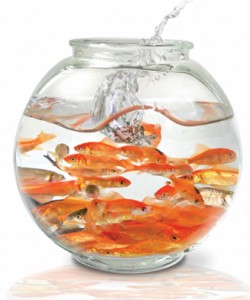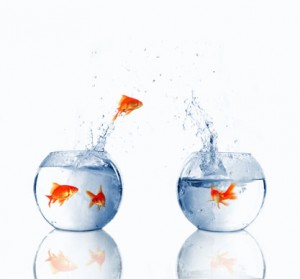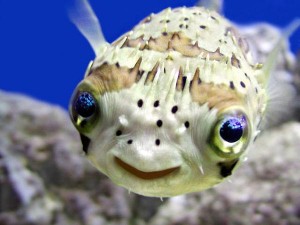…because I told you there would be fish rambles. I mentioned there would be fish rambles, didn’t I?
I know a LOT about fishkeeping. I have to: fish are my job. As such, a lot of people ask me fishkeeping questions, and because I was feeling, uh… fishy, I am here to provide a piscatorial post.
In specific, this is how to Start a Tropical Fish tank with Minimal Issues.
…well, okay. For the absolute minimum amount of issues, you should do all of this with a pinch of fish food in the water instead of live fish. But I know a lot of people are impatient, myself included, and you CAN do this with fish already in your tank.
See, this is a very common problem. People come in to my store to start a fish tank. They assume, 9 times out of 10, that keeping a fish tank involves sticking fish in a tank and leaving them there. Maybe poking the water once every couple of months. These are the people that are constantly having problems with it and usually swear off fishkeeping forever. But now, I will tell you the Secret to avoiding these issues all together! =D
Ready?
Before we begin: CRASH COURSE ON THE NITROGEN CYCLE IN FISH TANKS!
Fish eat and thus, fish poop. Fact o’ life, unfortunately. Fish poop turns into ammonia, which is very toxic to fish. Bacteria in your gravel will turn the ammonia into nitrite, which is still very toxic to fish, and eventually to nitrate, which is… toxic in high doses, but most freshwater fish can tolerate it in lower doses.
In a brand new fish tank, this “good bacteria” does not exist yet. Thus, while you are cycling a tank, it is up to YOU to make sure that the bad chemicals do not reach toxic levels.

HOW TO DO IT:
1.) MAKE SURE YOUR TANK IS NOT OVERSTOCKED. Marketing will show you pictures of five guppies in a three gallon mini-tank. Unfortunately, aquarium marketing, uh… is usually not accurate. “The Rule” is roughly one gallon for each inch worth of full grown fish. This rule is not set in stone. If you are willing to do a lot of work, you can bend it. And bigger fish (and goldfish) need more gallons per inch. But if you’re starting out with a fairly small tank, it’s a pretty good rule to follow.
2.) FOR BEST RESULTS PICK FAIRLY DURABLE FISH TO START OUT WITH. Zebra Danios and White Cloud Minnows are good choices. Platies are also pretty good. Do not use Mollies. They are notoriously sensitive to ammonia and thus are not a good cycling choice. Stuff like Neon Tetras and Barbs are difficult to use, but not impossible.
Got your tank set up? Got your fish? Good!
3.) WATER CHANGES. I know people hate doing these. Unfortunately it is basically the only way to get a good cycle going unless you wanna mess with chemicals and things. Do about a 25% water change every other day. This should keep the ammonia down to a manageable level. If you have a test kit, use it! Otherwise lots of pet places will do a water test for you for free.
The Ammonia Phase usually lasts 2-3 weeks, though it may vary depending on a lot of factors.
Once you get through the Ammonia Phase you will hit the Nitrite Phase. This means the ammonia on your test strip will lower a bit, and your nitrite pad will turn bright pink. The Nitrite Phase, in my experience, only lasts a few days. Continue doing the every-other-day water changes.
Not long after this you will do a water test and you will notice that your ammonia and nitrite counts are nice and low, but your nitrate is starting to rise. You may also start to notice algae growth around this time.
CONGRATULATIONS!
Your tank is cycled and you have just bypassed the issue that discourages probably 80% of first-timers from continuing in the fishkeeping hobby. Wasn’t that easy?
Now you can get more fish (if your tank has room for them). Be sure not to add more than a few fish at a time, as to not overload your little biological system.
4.) NOW WHAT? I am going to get on the soap box here and tell you something that you probably don’t want to hear. But I’m going to tell you anyway because I’m a firm believer in this. Ready?
Keep doing those crazy frequent water changes.
See, conventional wisdom says that once you hit the completely cycled Nitrate Phase, you can scale back your water changes to once a week or once every couple of weeks. Yes, you can probably do this and not suffer too many ill effects.
However, I recently saw a bunch of math done by fish geeks, complete with all sorts of charts and experiments, showing that conventional wisdom in this case pales in comparison to the beautiful fishkeeping results you’ll get with frequent water changes. See, even if Nitrate is the least toxic of the chemicals we’ve discussed here, it’s still, in the end, toxic. And it is Algae Food. Algae loves it some Nitrate.
I change 25% of the water in my fish tank every other day. My fish are brighter in color than any other fish I have ever seen. They are happier and more active than any other fish I have ever seen. I know you’ll accuse me of anthropomorphism here, but I swear to the Fish Gods that they get even happier for a few minutes after a water change. They are healthy– I have had these fish for months (or years in the case of one of them) and they have never been sick. And guess what: no algae. You heard me. No algae. Oh, I’ll get a couple flecks of it every few weeks. Takes five seconds to scrub it off. Far cry from the dozens of people who come into my store every week begging for an easy solution to their algae woes.
I have mentioned, before, that I can glance at a test strip and tell you how old someone’s tank is and make a good guess on how many fish they’ve got in there. Recently I tested my tank water. And let me tell you, if it had been someone else’s tank water, I’d have smiled politely and asked why they were asking me to test water that clearly had no fish in it. That’s how clean my water is, and that’s why my fish are so happy, healthy, and bright.
Can you get away with fewer water changes? Yes. Especially if your tank is sparsely stocked. But in fishkeeping, as with many hobbies, you get out of it what you put into it. Spending five minutes every other day doing a water change is worth it, to me.
*gets off soap box*
…did I just rant about fish? Sheesh. I am beyond hope.
Have a Puffer Fish:


A pet person who knows what they’re talking about when it comes to their pet of choice? You just keep getting better and better, I swear. It’s refreshing to see someone actually put in the effort for proper husbandry.
My interest in fish, while present, isn’t enough for me to actively start up aquarium keeping. (The last fish I had were food for my Ribbon Snake. Who sadly passed away almost exactly a year ago, now that I think of it.) But if I were interested, I’d certainly take the time to do at least a little bit of research into it.
As a reptile guy, I’ve heard many, many horror stories about people who get lizards, snakes, etc., and don’t know the first thing about keeping them. (Being close friends with someone who until recently did reptile rescues allowed me to learn a lot, even for species that I don’t keep.) My God, the things I’ve seen done with Iguanas…
This post makes me want to get some fish now. =) Does this apply to saltwater tanks also?
Yay informative fish posts!
I’d love to see a follow up some day on how to recover a tank in which the cycle has crashed.
>.>
<.<
No reason, why do you ask?
Wow, that was very informative and helpful. I have never heard that before. I don’t have any fish at present, but if I ever get some in the future, I will keep this in mind. Thanks!
That was.. random! The least interesting hobby in the world for me is fish, but still I’ve read your whole post. It *almost* makes me want to get a fish tank. Although I’ll probably end up as one of those people changing water once a year, along with dead fish. Yeah.. mm.. End of random post 🙂
@ Will – At my store, when people want to get a reptile/amphibian, I always try to warn them before hand that it will be pricey to set up. Most people don’t realize that and think you can just stick an anole in a tiny cage with some dirt or something. I definitely try to do my part to get people past this phase!
@ Sunset – Saltwater is trickier and depends on a lot of factors such as if you’re going to have live rock, coral, etc. To be honest I don’t know much about saltwater tanks, except that they take more investment to set up (but from what I understand, are pretty easy to maintain after that point).
@ Grimmtooth – Hee, my advice would be to just start from the top. Massive water changes! *nod*
@ Bamos – Glad to be of service!
@ Alina – Hehe. Fish sort of have to “grow” on you. I am a big addict now…
@Pike – Ayup, pretty much what I’m doing. If I still had my fish farm setup I’d just move ’em to a new tank, but those days are gone.
@Sunset & Pyke
Saltwater tanks are a little trickier to set up, and fishless cycling is currently the preferred method. They require a bit more effort, time, and extra cash to set up and maintain as well, especially if you decide to go with a reef tank(especially when some of the cooler fish can cost around $50 US). You also can’t keep as many animals(fish or inverts) since salt water doesn’t have as much oxygen in it as fresh. If you’re just starting out with fishkeeping, it’s better to get the basics down in freshwater(since mistakes in freshwater will cost you only a fraction of the time and money a mistake in a saltwater tank would).
I may have been ill-informed but when doing water changes I was told that the water going in needs to be at the same temperature as, or slightly warmer than, the water in the tank.
I’ve been getting pretty good at ‘feeling’ the water temperature and I recently did a 25% water change with our 10-gallon tank where the water temperature went up by just a couple of degrees. IIRC it was 82 when I started, and 84 when I finished.
Apparently fish can tolerate a somewhat rapid but still SMALL increase in water temperature, but a rapid decrease of even a few degrees can be fatal.
Do you just take water straight from the tap? And how important is matching temp?
Also, I heard somewhere that you could get rid of those nitrates with live plants, that like nitrates as tasty food. Sorta completing the cycle.